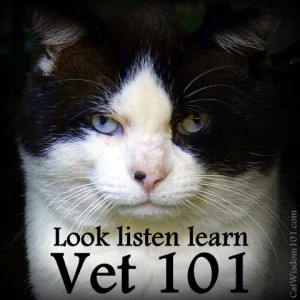Vet 101: Understanding Kidney Disease – Part Three

This is the last installment in a three part series on feline kidney diease by veterinarian Dr. Letrisa Miller. If you missed them, here are Part 1 and Part 2
Kidney Disease Part 3
In my last two posts, I addressed kidney disease in general and the first two stages of kidney disease. In today’s post I am addressing the symptomatic stages of kidney disease, stages 3 and 4.
Often the first mention of kidney disease from a veterinarian will be when a cat has reached stage 3 or 4. This is for two main reasons. First, these two stages have obvious signs that can be found on physical exam; for example, chronic dehydration and weight loss. Second, despite the IRIS staging system being widely accepted for a number of years, laboratories still list creatinine levels of up to 2.1 mg/dl as normal (IRIS stage 2) . Because of this some veterinarians may be confused about when to diagnose kidney disease or may simply be unaware that the IRIS staging system recognizes as abnormal creatinine levels that are lower than the reference laboratory’s upper “normal” range.
Whether your cat is newly diagnosed or has gradually moved into stage 3 or 4 kidney disease, care becomes more intensive.
Stage 3
Cats in IRIS stage 3 of kidney disease have a creatinine of 2.9 to 5.0 mg/dl, have dilute urine, and may or may not have hypertension (high blood pressure) and/or protein in the urine.
Stage three kidney disease is much the same as stage two, but more symptoms and more severe symptoms can be present. Most cats in this stage will have at least two of the common problems associated with kidney disease, and these often cause problems with appetite, thus causing weight loss.
Chronic low level dehydration is often a problem in cats in this stage. Cats in this group are usually seen by their veterinarian at least every three months for a check-up to monitor weight, blood pressure, and blood chemistry values. Urinalysis may be checked during these visits as well.
Another big change is that many cats may now require a prescription diet tailored to cats with kidney disease. At this stage many cats start to have significant problems with calcium and phosphorus levels. Protein restriction may be necessary to control BUN (blood urea nitrogen) levels and decrease phosphorus in the diet. Some cats may have to have phosphorus binders added to their food to control high phosphorus levels that can lead to mineralization of soft tissues like muscles (a process that can be likened to the soft tissues becoming bone-like)
Renal support diets have increased potassium, decreased protein levels, and decreased phosphorus levels. The ideal protein level for cats with kidney disease is not agreed upon, but I encourage protein intake to be at least 20 percent of dry matter.
Most cats in this stage, and some in stage two, will benefit from taking acid-blocking medications for the stomach to help prevent uremic ulcers. The kidneys play an active role in regulation of body pH, and cats with kidney disease often have chronic acidic pH of the blood and body. This and other changes can make them prone to gastric (stomach) ulcers that decrease appetite and cause pain and vomiting. Cats with these symptoms generally benefit from taking a drug such as famotidine (Pepcid).
Potassium loss often becomes significant enough in patients in this stage of kidney disease that they need a supplement. Signs of potassium deficiency are weakness and tiredness. Supplements come in several forms (pills, powder, gel) and can often be added to a cat’s food.
Calcium and phosphorus regulation often begin to be effected at this stage, and some clinicians have found that supplementation with vitamin D3 (calcitriol) is useful to keep the cat feeling well and eating well. This is a somewhat controversial treatment, but many veterinarians have good anecdotal evidence that the treatment is helpful.
Calcitriol can be given only in cats whose calcium multiplied by phosphorus is less than 70. Cats with a calcium-phosphorus product higher than 70 run the risk of calcification of soft tissues (such as muscle), and supplementation can increase calcium levels, thus increasing the risk.
If phosphorus levels start to rise above normal, the cat should be started on a renal diet with restricted phosphorus and may need to have phosphorus binders added to the diet as well..
Appetite can be poor in cats in this stage of kidney disease, so appetite stimulants often become necessary to keep weight on patients. The two most commonly used are mirtazapine (an antidepressant) and cyproheptadine (an antihistamine).
Do you remember that muscle mass and creatinine levels are related? This now becomes especially important because cats that are symptomatic for kidney disease often start losing weight, and usually their muscle mass is the first to go. Because of this, kidney function becomes harder and harder to assess. As muscle mass decreases, the level of creatinine in the blood also goes down, making creatinine a less useful measure of kidney function.
At this point the clinician has to start estimating how much muscle mass the cat has in order to interpret the meaning of creatinine levels. In other words a cat that has half the normal muscle mass and a creatinine of 3.0 probably has significantly worse kidney disease than a cat that has normal muscle mass and the same creatinine level. The doctor now has the added difficulty of no longer having an accurate way to assess kidney function in that skinny cat!
Stage 4 kidney disease is usually classified as “failure,” and patients in this category often see the veterinarian on a monthly basis. Some cats with dedicated caregivers can survive long periods at this stage, but most do not survive more than a few months unless they get a kidney transplant.
Almost all cats in this stage will have significant clinical symptoms of kidney disease such as chronic dehydration, constipation, weight loss, and anemia. Many cats in this group have a poor appetite and often have to be given fluid supplementation because they can’t drink enough water to maintain a hydration state that allows normal body function.
Cats in this group almost always have to be on a special diet to support their kidney function and give them extra non-protein calories.
All of the medications and testing mentioned above apply to this stage.
Dehydration is present in almost all stage-4 patients. Fluids can be supplemented by giving sterile saline under the skin or by having a tube implanted in the gastrointestinal tract to put water directly into the stomach or intestines. The second option is probably more comfortable for the cat and is a more normal way for the body to get fluid, but the initial placement of the tube is highly invasive and has the risk of anesthesia and surgical complications. Supplemental fluids are given as needed and can be as often as several times daily. Medication for uremic gastric (and other mucosa) ulcers is usually needed.
Controlling calcium and phosphorus levels in cats in stage usually becomes difficult, and phosphate binders may have to be added to their food. A number of binders available, and different veterinarians have different opinions about which should be used. Cats in this group often may have to be hospitalized periodically for IV fluid administration to manage acute crises caused by dehydration or illness.
Cats in this stage may feel ill a large part of the time, and quality of life should be assessed frequently.
The goal in my practice is to educate clients about the risks of kidney disease and to monitor for the disease throughout each cat’s life. By catching kidney disease in stages one or two, we can take steps to arrest its progress. Among my long-term clients, I see few cats with stage four kidney disease.
When cats come to me as new patients that already have advanced kidney disease, I stress with their caregivers the importance of thinking about what the cat enjoys doing, its favorite activities and places to go—in short, what gives it a good quality of life. I encourage clients to write down these things and put the list in a safe place. They can then periodically check the list and use it as a baseline to help them decide when “it is time.”
Kidney disease is something all cat owners should be aware of. It is not an uncommon disease in older cats, but if preventive medicine plans that include timely dental cleanings and blood chemistry monitoring as well as urinalysis are used, it can be avoided in many cats. And even those that develop disease despite preventive care have a good chance of long-term survival with a good quality of life if they receive thoughtful and timely care.
Dr. Letrisa Miller can be contacted via her website Connecticut Feline Medicine And Surgery




13 Comments
nike clothing size chart
We are a group of volunteers and opening a new scheme in our community. Your site provided us with valuable information to work on. You have done an impressive job and our whole community will be thankful to you.
jersey quilt designs names
Usually I don’t read article on blogs, but I wish to say that this write-up very forced me to try and do it! Your writing style has been surprised me. Thanks, quite nice post.
Cherry City Kitties
Our angel brother Arthur went to the Rainbow Bridge because of this disease. Now Mom knows a lot more about it and we won’t have to have that happen again. Thank you Miss Layla and Dr. Miller!
Harry, Dexter and Tipp
Maxwell, Faraday & Allie
Maxwell just had his timely dental cleaning today – and Faraday’s is next Friday. So we’re starting these boys on that regimen at a very early age. Thanks for this series – very insightful!
sue brandes
Thank you so much. My kitty has thyroid disease and they are always checking the kidneys too. So now I have an understanding of kidney disease.
Connie Marie
Excellent article. I learned alot.
Layla, you’re doing an excellent job with Merlin
it seems, from his pictures and the fact he had gained some weight
awhile ago. Must be extremely hard to bear though.
My thoughts are with you.
Connie
small business website design las vegas
fmeb92dkjp4, [link=http://bestcafeshops.com]jaket keren anak[/link] jaket keren buat cewek 75u8s84412dizwq, 6997 [link=http://www.smallbusinesswebdesign.co.uk]small business website design ottawa[/link] g1jejd3, 5624 [link=http://www.bingositesnet.co.uk/]bingo sites[/link].
Skeeter and Izzy
Thank you Dr. Miller! Your explainations have been so very informative and straight foward. Thank you Layla for providing a place for this type of information to be shared!
luvs and Purrs Skeeter and Izzy >^..^<
Abby
Excellent posting! Thank you for a clear concise overview.
da tabbies o trout towne
thanx for de posts theeze past few weeks….my mom now haza better understandin oh de stages oh this nastee dizease…..sum thin her dinna trooly haz five yeers ago….
XOXO
dude K RB cloud 777313
pheromones for women
pheromones queen witcher 2 [url=http://buypheromones.webs.com/]pheromones women[/url] pheromones guru [url=http://pheromone101.webs.com/]pheromonoes[/url] pheromones in humans [url=http://usepheromones.webs.com/]pheromones are advantageous because[/url].
Kathryn
Oh, my. What an excellent discussion. I will bookmark this, to keep watch on my two boyz, to make sure that neither Cheddar or Mao come down with this.
I hope that because they’re both on crystal dissolution and urinary forumla from the vet that this helps with kidney or over all health.
Brian
Such great info,. We bookmarked it with the hope that we never need it.